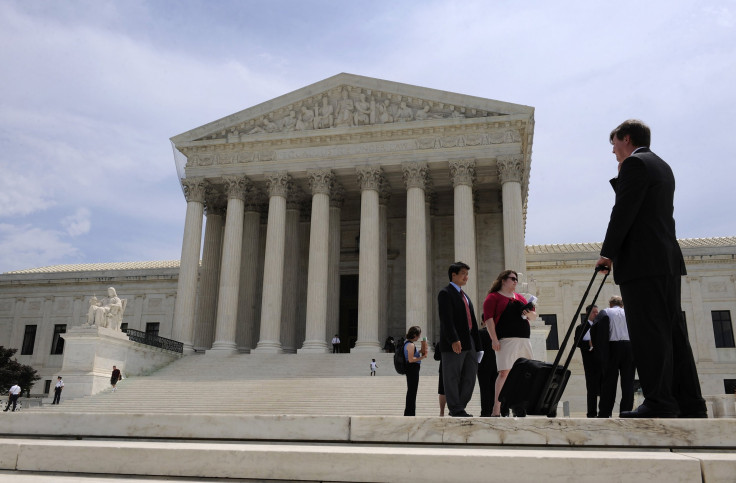The Next Citizens United? How The Supreme Court Could End Campaign Contribution Limits

In January 2010, the Supreme Court struck down limits on third party spending to influence elections. That decision, the famous Citizens United v. FEC, opened the door to the flood of super PAC money that characterized the 2012 election cycle.
Next month, the Supreme Court will hear a case that campaign finance advocates fear will be the next Citizens United – a case that could threaten the limits on how much an individual donor can give to a particular party or candidate. The case will be a clear sign of whether the court, with five solidly conservative justices, is open to tearing down what remains of the nation’s campaign finance laws.
Today, donors are confined by two types of contribution limits. Base limits set the upper bounds for how much an individual can give to a particular campaign ($2,600 per election), political action committee ($5,000) national party committee ($32,400 per calendar year) and state or local parties ($10,000 combined total per year). Aggregate limits set a total giving amount, which is $123,200 for the 2013-2014 cycle, divided between a maximum of $48,600 to candidates and $74,600 given to PACs and parties. Because the aggregate limit is lower than the sum of all the base limits, a donor can max out on giving in an election cycle without hitting the base limits for every federal candidate, PAC and party committee. It’s those aggregate limits that the wealthy Alabama businessman and frequent Republican donor Shaun McCutcheon, along with the Republican National Committee, is asking the Supreme Court to throw out.
If McCutcheon wins, individuals would be able to get around the base limits by donating up to $3.6 million, split between the candidates and party committees. Defenders of the aggregate limits see this as a problem because that state parties could coordinate to send all the money to the most important races, effectively circumventing the base limits by transferring millions of new dollars to the party's top races.
But it’s not just the aggregate limits that are keeping campaign finance reformers up at night: It’s possible that McCutcheon’s case could put the base limits in jeopardy as well. “It has this implication of undermining all contribution limits, and that’s sort of the reason why reform groups such as the [Campaign] Legal Center or others are saying that this could be the next Citizens United,” said Tara Malloy, senior counsel at the Campaign Legal Center, a nonpartisan group focused on money in politics.
Political spending is a protected speech right under the First Amendment, but not all election spending is created equal in the eyes of the court. Since the 1970s, the Supreme Court has drawn a distinction between spending on an election and donating to a candidate. Whereas spending, like putting an ad on television, is a direct expression of free speech, showing support through a donation is understood as a more indirect form of speech. As a result, the court has upheld contributions caps, privileging the government's interest in stopping corruption over the individual's speech rights. But if the court finds in McCutcheon's case that giving to a candidate is a free speech right on the same level as campaign spending, then the it will be signaling that all contribution limits are vulnerable to a challenge.
In its brief to the Supreme Court, the RNC argues that the aggregate limits are a heavier burden on free speech than the base limits. As a result, laws creating an aggregate limit should be evaluated more strenuously by the courts as prohibiting a protected right. Laws evaluated with this so-called "strict scrutiny," the highest review standard, are generally struck down because the individual rights being abridged are so vital they trump the public interest the law is trying to carry out. But the RNC goes a bit further, suggesting that the court could throw out the longtime precedent of viewing spending and contributions differently. If the court agrees, then laws limiting individual donations to campaigns would be open to a subsequent challenge.
“[S]trict scrutiny should apply because aggregate limits differ in kind from base limits,” the RNC brief to the court reads. The RNC goes on to argue that the court should also throw out the framework for evaluating campaign finance laws as established in a 1976 case called Buckley v. Valeo. “[T]his court should apply strict scrutiny, and it should overrule Buckley’s contribution/expenditure scrutiny dichotomy.”
“This is one of the more complicated aspects of the case, this question about how broadly it could impact all contribution limits,” said Malloy, referring to the different ways in which the court views contributions and expenditures. “This could possibly change the standard of review for all contribution limits, not just the aggregate limits but also these more typical base limits.”
Eliminating the so-called “contribution/expenditure scrutiny dichotomy” wouldn’t eliminate base limits immediately, but it would invite opponents of contribution limits to bring new cases over the issue. “[They] would immediately start challenging other types of contribution limits, and not only that, but we would be defending them with one hand tied behind our backs because suddenly the standard of scrutiny would be much more stringent,” Malloy said.
There’s no reason that the Supreme Court would have to go this far in their decision this fall – but if Citizens United is any guide, it’s not inconceivable. In that case, the court initially undertook a narrow question – whether a group called Citizens United could air an anti-Hillary Clinton movie within 30 days of the Democratic primary -- but on its own volition, went much further than the initial question in striking down longstanding outside spending limits.
“I would be fairly confident of success in McCutcheon,” Malloy said, citing the precedent on the side of maintaining contribution limits, “but that said, clearly the Supreme Court is fairly hostile toward all kinds of campaign finance laws.”
© Copyright IBTimes 2024. All rights reserved.






















